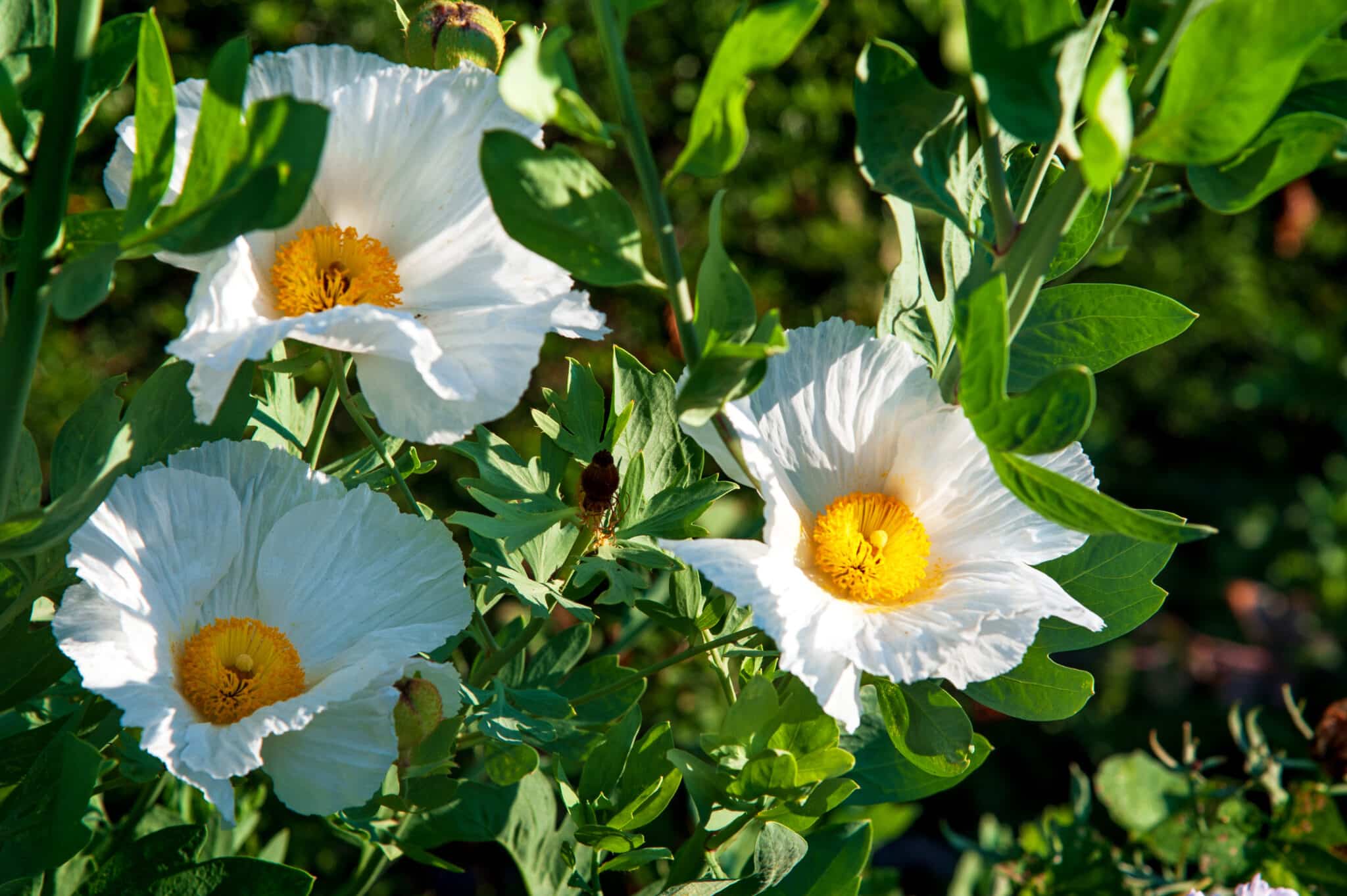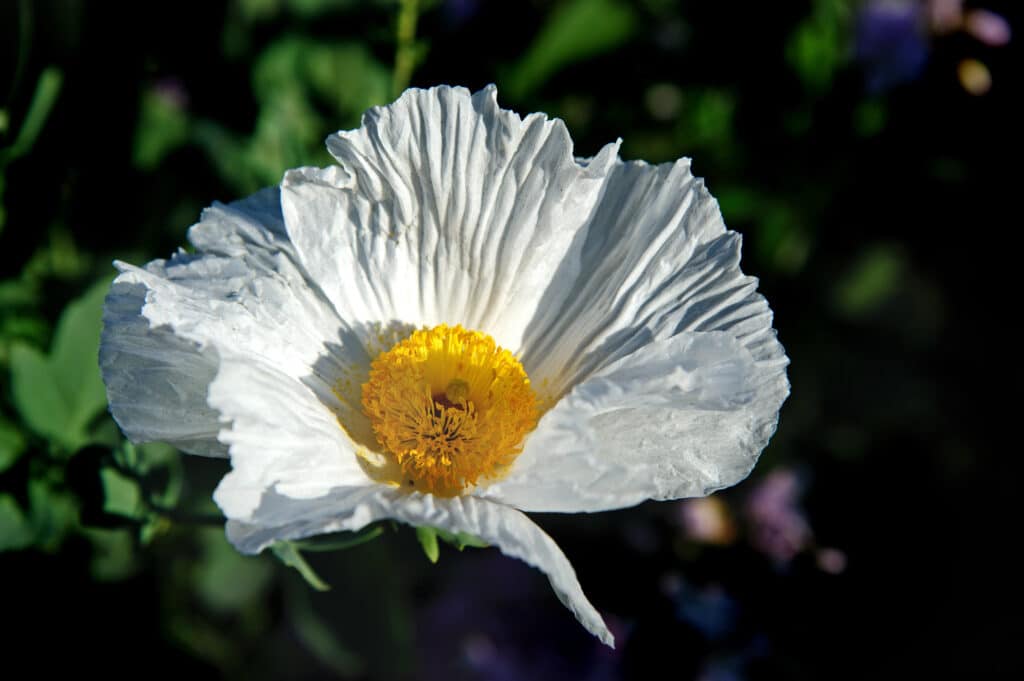Have you ever seen a flower so beautiful it seems almost magical? Meet Pua Kala, also known as the Hawaiian Poppy! Its scientific name is Argemone glauca, but locals know it as one of Hawaii’s unique treasures.
With its striking white petals and bright yellow center, Pua Kala isn’t just a pretty face—it’s a tough plant built to survive Hawaii’s rugged landscapes. Pua Kala is a native Hawaiian plant, meaning you won’t find it growing naturally anywhere else in the world.
It’s adapted to thrive in dry, rocky soils, making it a perfect fit for Hawaii’s diverse ecosystems. Beyond its natural beauty, this plant has a role in Hawaiian culture and ecology.
Pua Kala Details
Pua Kala, also known as the Hawaiian Poppy, is a striking native plant that grows to about 2 to 3 feet tall, with an upright and slightly bushy appearance. Its bluish-green leaves are deeply lobed with sharp, spiky edges, giving the plant a unique and rugged look perfectly suited to Hawaii’s harsh, rocky landscapes.
The plant’s flowers are its most iconic feature, boasting crisp white petals with a vibrant yellow center that serves as a magnet for native pollinators like bees.
After blooming, Pua Kala forms spiny seed pods, which hold numerous tiny black seeds that are dispersed to grow in dry, challenging environments. These pods, along with the plant’s overall structure, reflect its ability to adapt and thrive in Hawaii’s arid soils where other species might struggle.

Varieties and Cultivars
Pua Kala, the Hawaiian Poppy, is a native species endemic to Hawaii, meaning it does not naturally grow anywhere else in the world.
While there are no officially named cultivars of Argemone glauca, the plant does exhibit slight regional variations across the islands due to differences in climate and geography. Here are some notable variations and adaptations:
- Dry Lowland Variety: Found in arid, coastal regions, these plants tend to be smaller and more compact, with thicker leaves that help conserve moisture in the dry environment.
- Wet Upland Variety: In higher elevations with more rainfall, Pua Kala grows taller with more abundant foliage and larger flowers, showcasing how the plant adapts to wetter conditions.
- Volcanic Slope Adaptation: On rocky volcanic soils, this variation often displays even deeper-colored bluish-green leaves and more spiny seed pods, which aid in its survival in nutrient-poor soils.
These regional adaptations highlight the plant’s incredible versatility and ability to thrive in Hawaii’s diverse microclimates.
Despite these differences, the core characteristics of Pua Kala remain consistent—its iconic white petals with yellow centers and its ability to grow in some of the toughest conditions on the islands.
Best Time to Plant
Year-Round Planting Feasibility
One of the best things about Pua Kala is its ability to be planted almost any time of the year in Hawaii. Thanks to the islands’ consistent tropical climate, the plant thrives regardless of the season as long as its basic needs are met.
While it can survive being planted during the dry season, it requires a little extra attention with regular watering to ensure successful germination and establishment.
However, if you prefer a low-maintenance start, planting during the wet season gives Pua Kala a natural boost from rainfall, allowing it to settle into the soil without much intervention.
Ideal Planting Seasons in Hawaii
Though Pua Kala is a tough and adaptable plant, Hawaii’s wet season (November to April) is the best time to plant it. The natural rainfall during this period helps the seeds germinate and the young plants establish their roots without the need for frequent hand watering.
On the other hand, the dry season (May to October) can also work for planting, provided you’re able to supply additional water during the critical early stages of growth. Once established, Pua Kala is highly drought-tolerant, making it perfect for landscapes that require minimal maintenance. Timing your planting with these seasonal shifts ensures the best results with the least effort.
Growing Conditions
Ideal Soil Types and pH Levels
Pua Kala thrives in poor, rocky, or sandy soils, making it one of the most resilient native plants in Hawaii. It does not require nutrient-rich or heavily amended soil to flourish, which makes it an excellent option for areas where other plants may struggle.
The ideal soil for Pua Kala is well-draining, as it does not tolerate standing water or soggy conditions. It prefers a slightly alkaline to neutral pH range, typically between 6.5 and 7.5, though it can adapt to slightly acidic conditions if drainage is sufficient. If you have rocky terrain or bare patches of soil in your yard, Pua Kala will feel right at home.
Light Requirements
Sunlight is essential for Pua Kala to thrive, as it is a sun-loving plant that performs best in full sun. Choose a location in your garden that receives at least 6 to 8 hours of direct sunlight daily to ensure healthy growth and abundant flowering.
While it can tolerate partial shade, less light often results in fewer blooms and slower development. Its natural habitat in Hawaii’s open, sunny landscapes reflects its need for bright and consistent exposure to the sun.
Temperature and Humidity Preferences
Pua Kala is perfectly suited to Hawaii’s warm, tropical climate. It thrives in moderate to high temperatures and can easily handle the natural fluctuations between the islands’ wet and dry seasons.
Unlike some plants that are sensitive to humidity, Pua Kala adapts well to both the higher humidity of the wet season and the drier conditions during summer. Its ability to survive in these conditions makes it a low-maintenance choice for gardens across the islands.
Drought Tolerance
One of Pua Kala’s standout features is its drought tolerance. Once established, it requires minimal watering, even during Hawaii’s dry season. This makes it an ideal plant for xeriscaping, native gardens, or other low-water landscaping projects.
The plant’s deep root system and waxy leaves help it conserve moisture and survive long periods without rainfall. This quality not only ensures its survival in harsh conditions but also makes it an excellent choice for gardeners looking to reduce water usage.
Planting Instructions
Step-by-Step Guide
Planting Pua Kala is a straightforward process that ensures you can enjoy this resilient native plant in your garden or restoration project. Here’s how to do it step by step:
- Choose the Perfect Spot: Start by selecting a sunny location with well-draining soil. This is crucial for Pua Kala to thrive, as it doesn’t tolerate wet or overly fertile conditions.
- Prepare the Soil: Clear out any weeds and loosen the soil to create a welcoming environment for the seeds or seedlings. This simple step ensures your plant has room to establish strong roots.
- Plant the Seeds or Seedlings: Scatter the seeds on the soil surface and press them gently without burying them too deeply, or place seedlings in shallow holes just large enough for their roots. Proper planting depth is essential for healthy growth.
- Water Lightly: In the first few weeks, water sparingly to keep the soil slightly moist but not soggy. This helps the seeds germinate or the seedlings adapt to their new environment.
- Watch it Grow: With minimal care, Pua Kala will establish itself and flourish. Over time, its natural resilience will make it a low-maintenance addition to your garden.
By following these steps, you’ll ensure a healthy and vibrant Pua Kala plant that thrives in your landscape.
Tips for Successful Establishment
Starting your Pua Kala plants off right can make all the difference in their long-term health and beauty. Keep these tips in mind to give your plant the best possible start:
- Plant During the Wet Season: The natural rainfall during Hawaii’s wet season will reduce the need for extra watering and help seeds or seedlings establish quickly. This is the easiest way to ensure success.
- Avoid Overwatering: Too much water can damage Pua Kala’s roots and lead to root rot. Let the soil dry out between watering sessions to maintain the plant’s natural balance.
- Protect Young Plants: Keep the area around the seedlings clear of invasive weeds that could compete for nutrients and space. This small effort helps Pua Kala grow strong and flourish.
These tips will give your Pua Kala the best chance to grow into a robust and beautiful plant, even in challenging conditions.
Considerations for Native Habitat Restoration
Pua Kala is an excellent candidate for native habitat restoration projects, thanks to its ability to thrive in harsh environments. It helps prevent soil erosion, supports pollinators like bees, and encourages the regeneration of Hawaii’s unique ecosystems.
When planting Pua Kala for restoration purposes, ensure the site matches its natural habitat—well-drained, sunny, and not overly fertile—to maximize its success and ecological benefits.

Care and Maintenance
Watering Needs
Caring for Pua Kala is refreshingly simple, and its watering needs are minimal once established. During the early stages, water the plant lightly but regularly to help it settle into the soil and establish strong roots.
Once it’s established, Pua Kala becomes highly drought-tolerant and can survive on natural rainfall, even during Hawaii’s dry season. Avoid overwatering, as the plant prefers well-draining soil and is sensitive to standing water, which can lead to root rot.
This low-maintenance watering routine makes Pua Kala a great choice for gardeners seeking hardy, resilient plants for arid or rocky landscapes.
Fertilization Recommendations
Fertilizing Pua Kala is generally unnecessary, as this plant thrives in poor, rocky soils without added nutrients. In fact, it prefers low-nutrient environments that mimic its natural habitat. Adding fertilizer can sometimes do more harm than good by encouraging overgrowth or weakening the plant’s natural defenses.
If you want to give it a boost, consider using a very light application of organic compost, but keep it minimal. Trust in Pua Kala’s natural ability to thrive without intervention—it’s part of what makes this plant so special and easy to care for.
Pruning Guidelines
Pruning Pua Kala is not required often, but it can help keep the plant looking tidy in your garden. After the flowering season, you can remove spent flowers to encourage a clean appearance and prevent excessive seed production if you want to control its spread.
Be cautious of the plant’s spiny seed pods, as they can be sharp, so it’s best to use gloves while handling. If any leaves or stems become damaged or dried out, prune them back to maintain the plant’s overall health and appearance. With minimal effort, your Pua Kala will continue to be a stunning focal point in your landscape.
Common Problems and Solutions
Common Pests
This tough plant is highly resistant to pests, but occasionally, a few may appear. Common pests include:
- Aphids: These small insects feed on the leaves and stems, causing minor damage.
- Caterpillars: Some caterpillars may nibble on the leaves, but they rarely cause serious harm.
- Spider Mites: In very dry conditions, spider mites may appear and create webbing on the underside of leaves.
These issues are typically manageable with simple solutions, such as rinsing the plant with water or applying a mild soap spray.
Common Diseases
Diseases are uncommon but can occur in specific situations. Some issues to watch for include:
- Root Rot: Caused by overwatering or poor drainage, this is the most common problem.
- Powdery Mildew: A fungal disease that can appear in humid, shaded conditions, leaving a white coating on leaves.
- Leaf Spot: Occasionally, dark spots may appear on leaves due to fungal infections in overly moist environments.
These problems can generally be avoided by ensuring the plant is grown in full sun with well-drained soil.
Preventative Measures and Treatments
Proactively maintaining healthy growing conditions is the best way to prevent problems. Avoid overwatering to keep the soil well-drained and prevent root rot. Ensure the plant gets full sun and is spaced out to allow good air circulation, which reduces the risk of fungal infections like powdery mildew.
For pests, use natural solutions such as a gentle water rinse or companion planting to deter insects. Regular monitoring for early signs of pests or diseases allows for quick interventions, ensuring the plant remains vibrant and strong.
Uses and Landscaping Tips
This plant is not only a symbol of resilience but also a versatile addition to various landscaping designs. Its ability to thrive in dry, rocky, and low-nutrient soils makes it a fantastic choice for xeriscaping, where water conservation is a priority.
The striking white flowers with vibrant yellow centers provide a beautiful contrast to green foliage, making it an eye-catching feature in native gardens or along walkways.
It is particularly valuable in restoration projects, where its deep roots stabilize soil, prevent erosion, and support native biodiversity. Whether used in decorative gardens or ecological projects, it adds a unique touch to any space and helps sustain Hawaii’s natural environment.
Propagation Methods
Growing this hardy native plant is easier than you might think, and propagation is typically done through seeds. Its seed pods, which are covered in spines, contain numerous tiny black seeds that can be harvested once the pods dry out and crack open naturally.
To propagate, collect these seeds and scatter them on the soil surface in a well-drained, sunny location. There’s no need to bury them deeply; a light pressing into the soil is sufficient. This mimics how the plant naturally propagates in the wild, where seeds fall and germinate with the help of rain and sunlight.
Environmental Impact and Benefits
Ecological Benefits
This native plant plays a significant role in Hawaii’s ecosystems, making it more than just a beautiful addition to the landscape. Its flowers provide an essential source of nectar and pollen for native pollinators, such as bees and butterflies, which are vital for maintaining ecological balance. The plant’s deep root system helps prevent soil erosion, especially in dry or rocky areas where vegetation is sparse.
It also contributes to biodiversity, creating habitats for small insects and other wildlife that depend on native flora. By thriving in challenging conditions, it serves as a key species in areas where other plants might fail, helping to sustain Hawaii’s natural landscapes.
Potential Drawbacks
While this plant offers numerous benefits, there are a few considerations to keep in mind. Its spiny seed pods, though part of its natural adaptation, can be sharp and may pose a minor risk if handled carelessly or if planted near walkways where people frequently pass.
Additionally, its limited availability may make it challenging to source seeds or seedlings for personal gardens. Sensitivity to disturbance is another factor; while it thrives in harsh conditions, significant disruption to its native habitat, such as land clearing or invasive species competition, can hinder its growth.
Conclusion
This plant is not just a stunning native flower, but a symbol of resilience and ecological balance in Hawaii. From its ability to thrive in arid, rocky soils to its vital role in supporting native pollinators and preventing soil erosion, it is a true asset to the islands’ ecosystems.
Whether you’re looking to add a low-maintenance, drought-tolerant plant to your garden or contribute to native habitat restoration, this species is an excellent choice for any landscape in Hawaii. Its natural beauty, adaptability, and ecological benefits make it a standout among Hawaii’s endemic plants.


